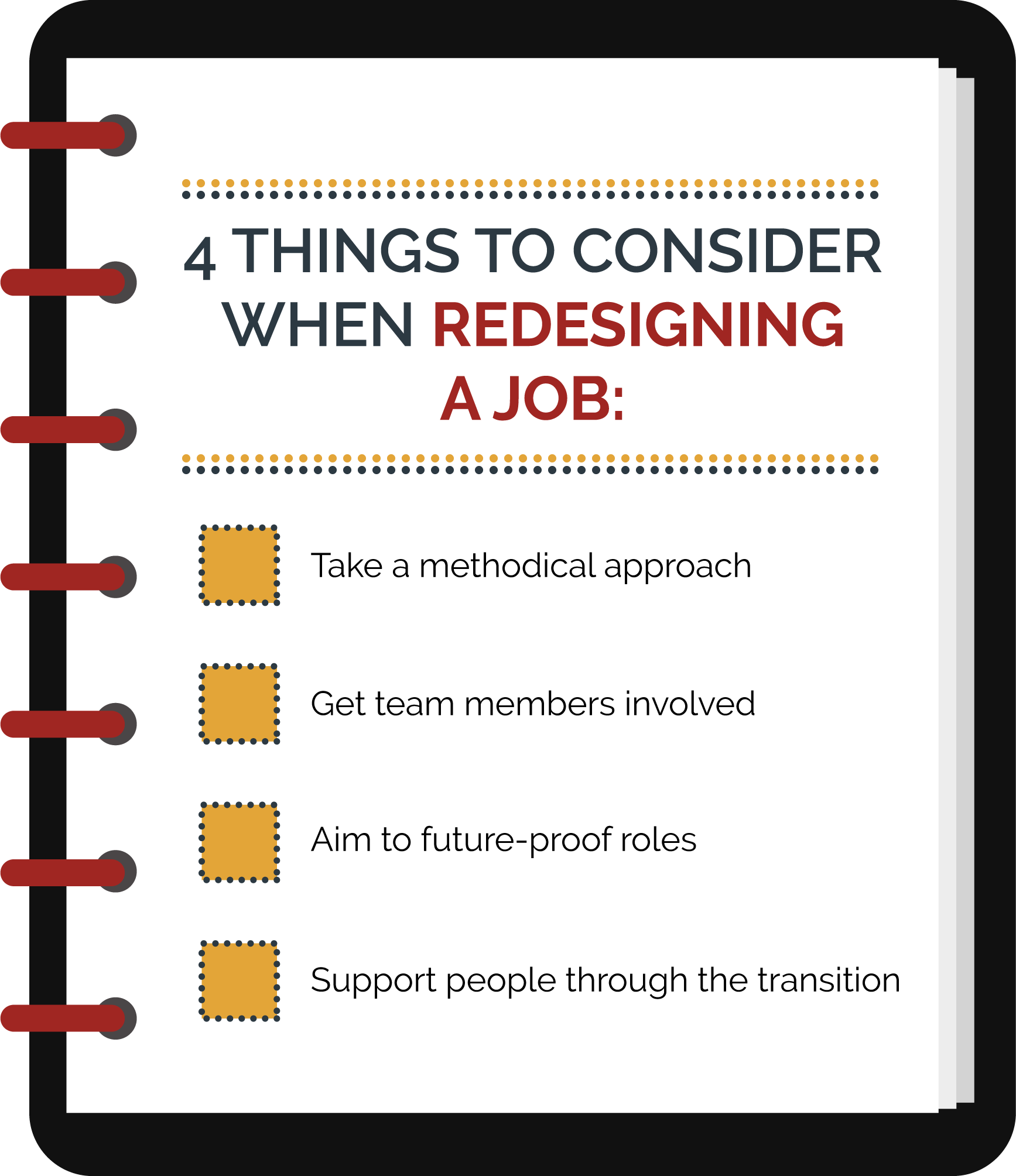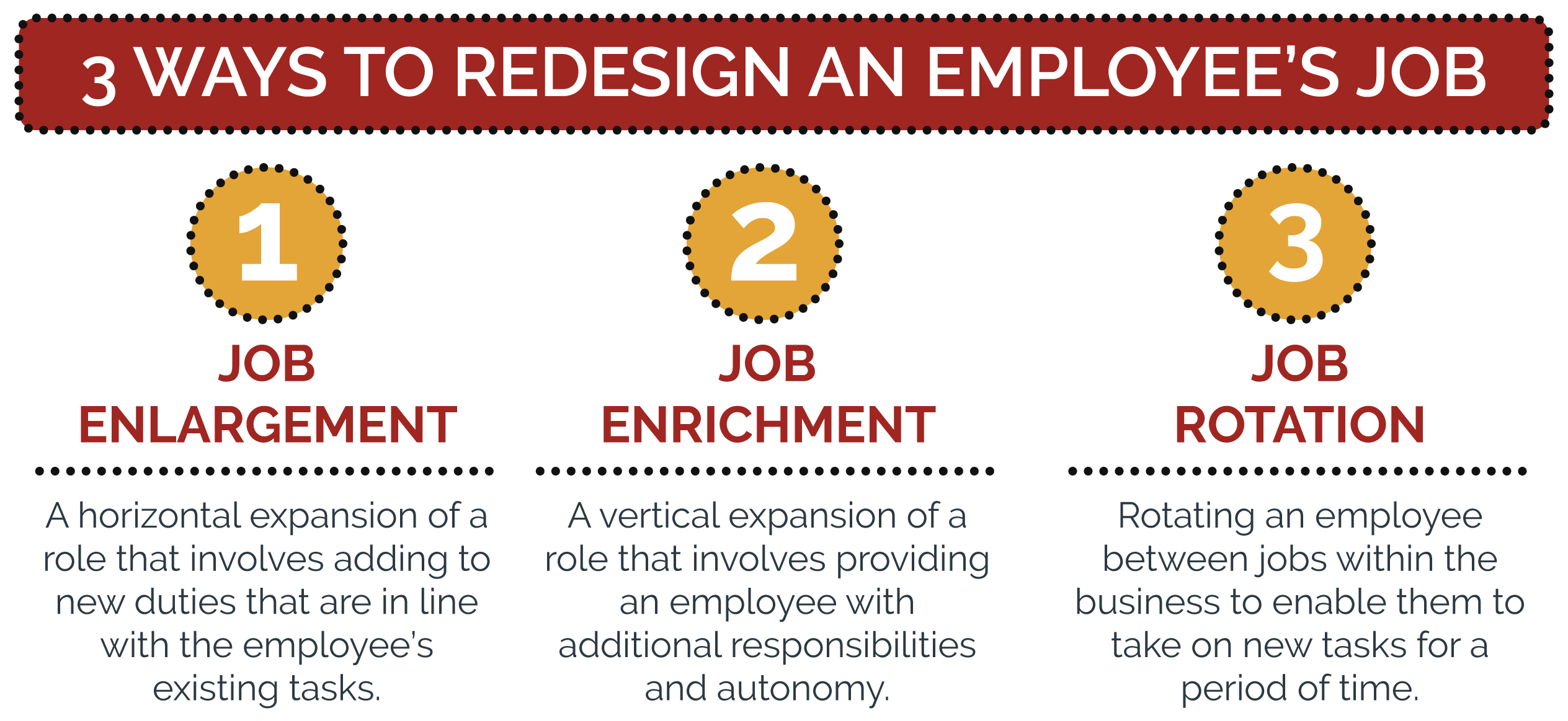The world is changing every day, and jobs are changing alongside it. With recent global events demonstrating just how volatile the market is at times, it’s clear that leaders need to be prepared to constantly adapt their organisations and the individual roles of team members in response to shifting market conditions.
Job redesign is the process of reviewing aspects of an employee’s responsibilities and restructuring (or reallocating) the scope and depth of their tasks, specifically through job enrichment, job enlargement and job rotation. This is an excellent way for employers to not only pivot jobs when necessary, but also to potentially improve the individual’s productivity, motivation and job satisfaction – not to mention retention.
Research shows that job redesign can have a significant effect on engagement levels, but as with any change, there are also some challenges that must be managed carefully to avoid a negative impact on employee morale. For example, some people may be concerned about the security of their role, the reason it is being redesigned and whether it will become more difficult to perform as a result.
To combat this, leaders should focus on adding more value to a person’s work, taking into account the unique abilities and experience they bring to a role and ensuring the employee feels that they are assets to the business. Here’s our specific advice on how to redesign an employee’s job in a way that keeps them engaged while also maximising the performance and commercial success of the organisation in the evolving business landscape.
Keeping Employees Engaged When Redesigning Jobs
Job redesign is a complex process that should not be taken for granted. These tips for maintaining employee engagement during job redesign will guide you in ensuring roles continue to benefit both the team members and the organisation.
Approach job redesign methodically

During the job redesign process, aim to cover each of these key steps:
- Collect and analyse all information related the job to determine any inconsistencies between the person and the role, as well as identify anything that may be hindering performance.
- Amend the job elements to meet the needs of both the employee and the business where possible, including removing unnecessary responsibilities and adding more functions or autonomy.
- Reform the job description and performance measures according to the changes made to ensure the employee is able to deliver what is expected of them.
- Reallocate altered tasks and functions to employees (whether by rotating, enriching or enlarging the job) with the aim of increasing employee satisfaction.
Get the team involved
Since they’re the ones that perform their roles in the day-to-day, your employees likely have some idea about the changes and improvements they’d like to make. While the leadership team obviously has the clearest understanding of the business’ strategic vision, it’s still worthwhile getting the input of the team to help inform decision making.
Consult everyone individually and ask them about where they think they could add the most value to the organisation, as anything that is not working as well as it could. It’s also a good idea to consider their skills and personal goals when making a change, as this will ensure they are motivated and satisfied with their work.
Aim to future-proof jobs through redesign
Job redesign is essential for employees to be successful and productive in the future of work, so be sure to keep a future focus when redesigning a job. Think about how the role could evolve in the near- or longer-term, including strategic or technological developments that may impact requirements. While it isn’t possible to guarantee that a job will be completely future-proofed, you can begin to anticipate new needs and changes.
Also, keep in mind that you shouldn’t overly tailor a role to the abilities and preferences of a certain employee, as this can make it difficult to fill the role later down the track if that person were to depart. Instead, take a wider view and consider how to role will complement the rest of the team as well.
Support people through the transition
Finally, remember that any time an employee changes positions or gains new responsibilities, it’s likely that a transition period will be involved. Be active in providing additional training, mentorship and one-on-one support where required, and regularly check in with people to get feedback on how the new arrangement is working.
Doing so will not only help the entire team adapt more quickly, but it will give all impacted employees the best chance to thrive in their new and improved roles.
Closing Thoughts
Obviously, for smaller businesses, the job redesign process will be less formal and more agile, involving a conversation with the employee around what they are doing and any changes to their work – however, it can still be beneficial to keep this tips in mind.
When done right, redesigning a job can ensure it continues to align with the needs of the business and the external environment, while also fitting with the employee’s abilities and motivators. By following these job redesign best practices, you will be able to maximise employee engagement and continue to effectively leverage your organisation’s talent for years to come.
If you are in the process of redesigning jobs and have identified a talent gap in your business, get in touch with our team of recruitment specialists at First People Recruitment Solutions to find out how we can help you secure the best Indigenous and non-Indigenous candidates Australia has to offer.




